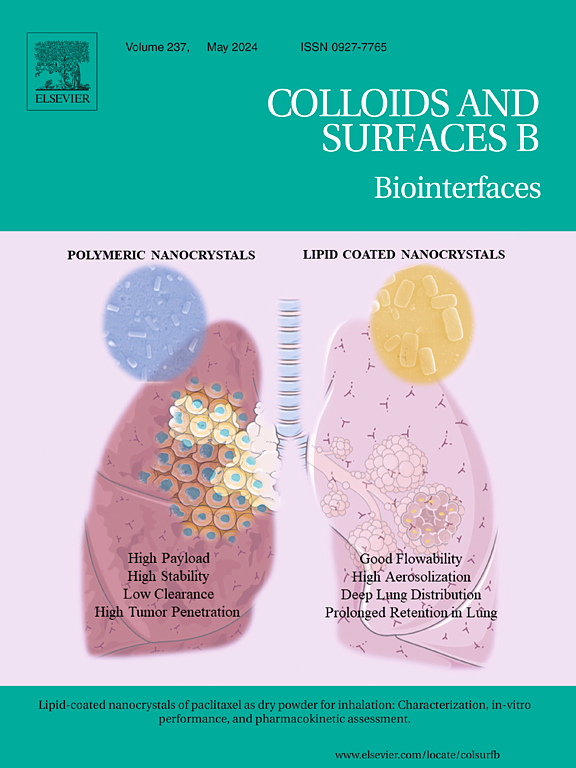基于核酸的药物递送纳米凝胶:从构建策略到智能应用
IF 5.4
2区 医学
Q1 BIOPHYSICS
引用次数: 0
摘要
纳米凝胶是通过分子内或分子间交联形成的纳米级水凝胶颗粒。由于其高稳定性、优异的生物相容性和对环境刺激的智能反应性,它们在药物递送中作为多功能载体。基于核酸的纳米凝胶由于核酸的独特特性而引起特别的兴趣。基于核酸的纳米凝胶不仅具有纳米材料和水凝胶的特性和功能,而且其优异的柔韧性、稳定性、精确的可编程性和可调节性使其在生物医学领域大放异域。此外,功能核酸,如microRNA、小干扰RNA、i-motif纳米结构等,为核酸基纳米凝胶的构建提供了辅助,提供了额外的刺激反应、分子识别、疾病治疗潜力,成为生物医学应用的关键参与者。因此,总结核酸基纳米凝胶的现有制备策略、生物学特性和最新应用,有助于寻找纳米载体的发展新方向。本文综述了核酸基纳米凝胶的各种合成策略和给药机制。讨论了智能纳米凝胶的保护和功能修饰,概述了其在生物医学上的应用,并探讨了未来的发展方向。这一综述将促进新型核酸基纳米凝胶的发展,并为一系列疾病的治疗干预带来新的活力。本文章由计算机程序翻译,如有差异,请以英文原文为准。
Nucleic acid-based nanogels for drug delivery:From construction strategies to intelligent applications
Nanogels are nanoscale hydrogel particles, formed through intramolecular or intermolecular cross-linking. They serve as versatile carriers in drug delivery due to their high stability, excellent biocompatibility, and intelligent responsiveness to environmental stimuli. Nucleic acid-based nanogels are of particular interest due to the unique characteristics of nucleic acids. Nucleic acid-based nanogels not only possess the properties and functionalities of nanomaterials and hydrogels, but also its excellent flexibility, stability, precise programmability and adjustability makes them shine in the biomedical field. In addition, functional nucleic acids, such as microRNA, small interfering RNA, i-motif nanostructures, etc., provide assistance for the construction of nucleic acid-based nanogels to provide additional stimulus response, molecular recognition, disease treatment potential, making them key participants in biomedical applications. Therefore, it is crucial to summarize the existing preparation strategies, biological properties and recent applications of nucleic acid-based nanogels, which can help to seek new directions for the development of nanocarriers. This review summarizes various synthesis strategies and drug delivery mechanisms of nucleic acid-based nanogels. It also discusses protective and functional modifications for intelligent nanogels, outlines their biomedical applications, and explores future development directions. It is anticipated that this review will facilitate the development of novel nucleic acid-based nanogels and bring new vitality to therapeutic interventions for a range of diseases.
求助全文
通过发布文献求助,成功后即可免费获取论文全文。
去求助
来源期刊

Colloids and Surfaces B: Biointerfaces
生物-材料科学:生物材料
CiteScore
11.10
自引率
3.40%
发文量
730
审稿时长
42 days
期刊介绍:
Colloids and Surfaces B: Biointerfaces is an international journal devoted to fundamental and applied research on colloid and interfacial phenomena in relation to systems of biological origin, having particular relevance to the medical, pharmaceutical, biotechnological, food and cosmetic fields.
Submissions that: (1) deal solely with biological phenomena and do not describe the physico-chemical or colloid-chemical background and/or mechanism of the phenomena, and (2) deal solely with colloid/interfacial phenomena and do not have appropriate biological content or relevance, are outside the scope of the journal and will not be considered for publication.
The journal publishes regular research papers, reviews, short communications and invited perspective articles, called BioInterface Perspectives. The BioInterface Perspective provide researchers the opportunity to review their own work, as well as provide insight into the work of others that inspired and influenced the author. Regular articles should have a maximum total length of 6,000 words. In addition, a (combined) maximum of 8 normal-sized figures and/or tables is allowed (so for instance 3 tables and 5 figures). For multiple-panel figures each set of two panels equates to one figure. Short communications should not exceed half of the above. It is required to give on the article cover page a short statistical summary of the article listing the total number of words and tables/figures.
 求助内容:
求助内容: 应助结果提醒方式:
应助结果提醒方式:


